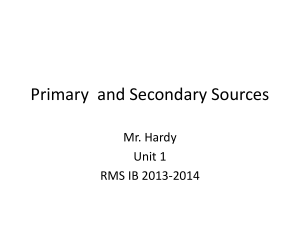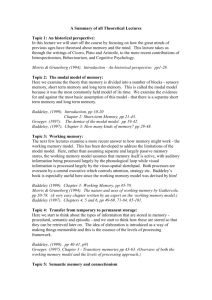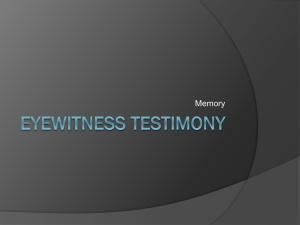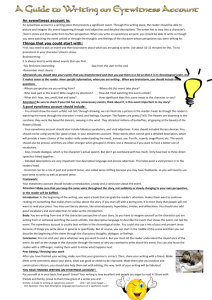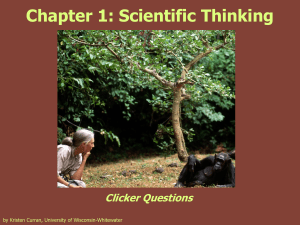A Summary of all Applied Lectures
advertisement
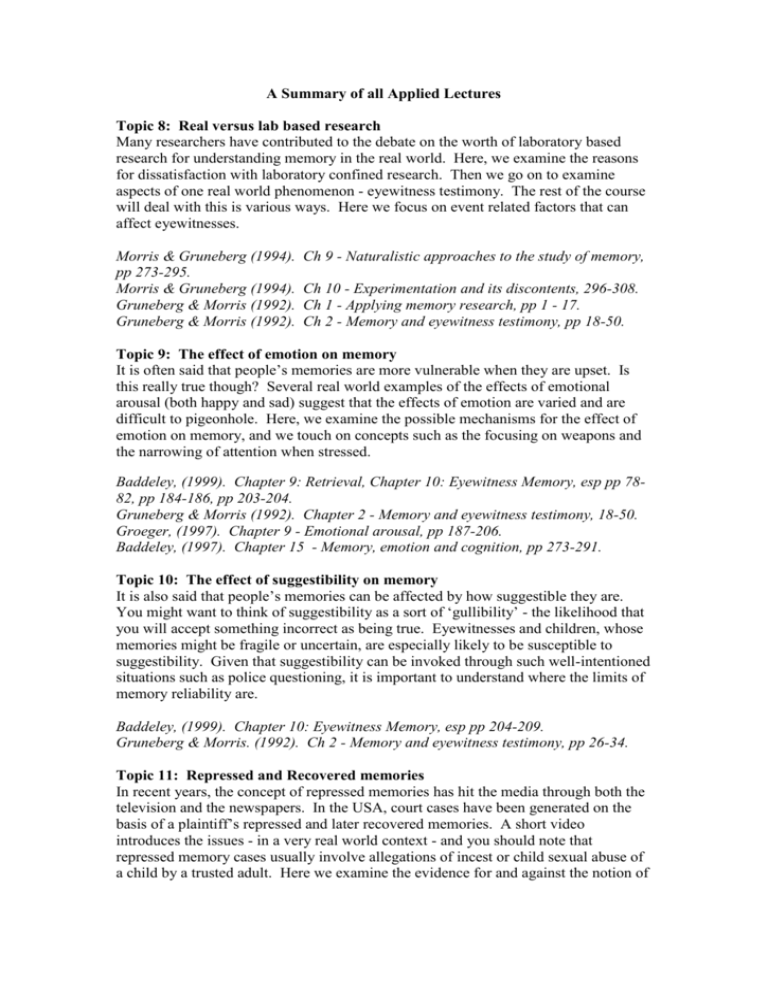
A Summary of all Applied Lectures Topic 8: Real versus lab based research Many researchers have contributed to the debate on the worth of laboratory based research for understanding memory in the real world. Here, we examine the reasons for dissatisfaction with laboratory confined research. Then we go on to examine aspects of one real world phenomenon - eyewitness testimony. The rest of the course will deal with this is various ways. Here we focus on event related factors that can affect eyewitnesses. Morris & Gruneberg (1994). pp 273-295. Morris & Gruneberg (1994). Gruneberg & Morris (1992). Gruneberg & Morris (1992). Ch 9 - Naturalistic approaches to the study of memory, Ch 10 - Experimentation and its discontents, 296-308. Ch 1 - Applying memory research, pp 1 - 17. Ch 2 - Memory and eyewitness testimony, pp 18-50. Topic 9: The effect of emotion on memory It is often said that people’s memories are more vulnerable when they are upset. Is this really true though? Several real world examples of the effects of emotional arousal (both happy and sad) suggest that the effects of emotion are varied and are difficult to pigeonhole. Here, we examine the possible mechanisms for the effect of emotion on memory, and we touch on concepts such as the focusing on weapons and the narrowing of attention when stressed. Baddeley, (1999). Chapter 9: Retrieval, Chapter 10: Eyewitness Memory, esp pp 7882, pp 184-186, pp 203-204. Gruneberg & Morris (1992). Chapter 2 - Memory and eyewitness testimony, 18-50. Groeger, (1997). Chapter 9 - Emotional arousal, pp 187-206. Baddeley, (1997). Chapter 15 - Memory, emotion and cognition, pp 273-291. Topic 10: The effect of suggestibility on memory It is also said that people’s memories can be affected by how suggestible they are. You might want to think of suggestibility as a sort of ‘gullibility’ - the likelihood that you will accept something incorrect as being true. Eyewitnesses and children, whose memories might be fragile or uncertain, are especially likely to be susceptible to suggestibility. Given that suggestibility can be invoked through such well-intentioned situations such as police questioning, it is important to understand where the limits of memory reliability are. Baddeley, (1999). Chapter 10: Eyewitness Memory, esp pp 204-209. Gruneberg & Morris. (1992). Ch 2 - Memory and eyewitness testimony, pp 26-34. Topic 11: Repressed and Recovered memories In recent years, the concept of repressed memories has hit the media through both the television and the newspapers. In the USA, court cases have been generated on the basis of a plaintiff’s repressed and later recovered memories. A short video introduces the issues - in a very real world context - and you should note that repressed memory cases usually involve allegations of incest or child sexual abuse of a child by a trusted adult. Here we examine the evidence for and against the notion of repressed and recovered memories by drawing on what we know about the effect of emotion and suggestibility. Baddeley, (1999). Chapter 7: Repression, pp 131-144. Groeger, (1997). Chapter 10 - Remembering one’s self, pp 230-235. Baddeley, (1997). Chapter 15 - Memory, emotion and cognition, pp 273-291. Topic 12: Investigative Interviewing Given all the influences on the memory of the eyewitness (event-related factors and witness-related factors) it seems sensible and necessary that the legal system is made aware of the fallibility and the limits of the human memory. This is especially important given the weight assigned to the testimony of an eyewitness in a court of law. Modern procedures and theory-driven developments are assessed, highlighting the importance of the cognitive interview, and the modifications of this technique for use with young children. Baddeley, (1999). Chapter 9: Retrieval, pp 178-191. Chapter 10: Eyewitness Memory, pp 199-218. Gruneberg & Morris (1992). Ch 2 - Memory and eyewitness testimony, pp 34-45. Groeger, (1997). Chapter 11 - Exceptional remembering, pp 249-253. Topic 13: Eyewitness Identification In this lecture, we will be examining the lessons that memory research has given us for determining the best procedures for eyewitness identification. Research on how a culprit may be perceived, described, recalled and finally recognised, will be examined, and recent developments in line-up procedures will be evaluated. Baddeley, (1999). Chapter 9: Retrieval, pp 178-191. Chapter 10: Eyewitness Memory, pp 199-218. Gruneberg & Morris (1992). Ch 2 - Memory and eyewitness testimony, pp 34-45. Groeger, (1997). Chapter 11 - Exceptional remembering, pp 249-253. Topic 13: Amnesia There are three sessions on this fascinating topic. In the first, we will be introduced by video to several amnesic patients and will have an opportunity to see exactly what has gone wrong with their memories and how this affects their daily lives. In the second, we will begin to examine what might cause amnesia, as well as what has happened to the brain. Finally, the third lecture will assess what has happened to the patient, and how rehabilitation can be assisted. Baddeley, (1999). Introduction, pp 1-3 Chapter 11: Amnesia, pp 219-236. Groeger, (1997). Chapter 14 - Memory dysfunction, pp 299-323. Baddeley, (1997). Chapter 16 – Understanding Amnesia, pp 293-310.
